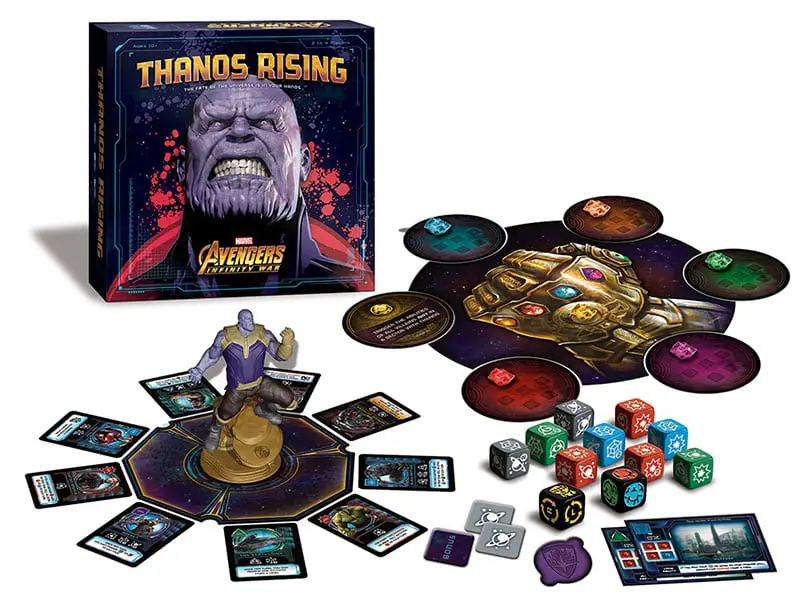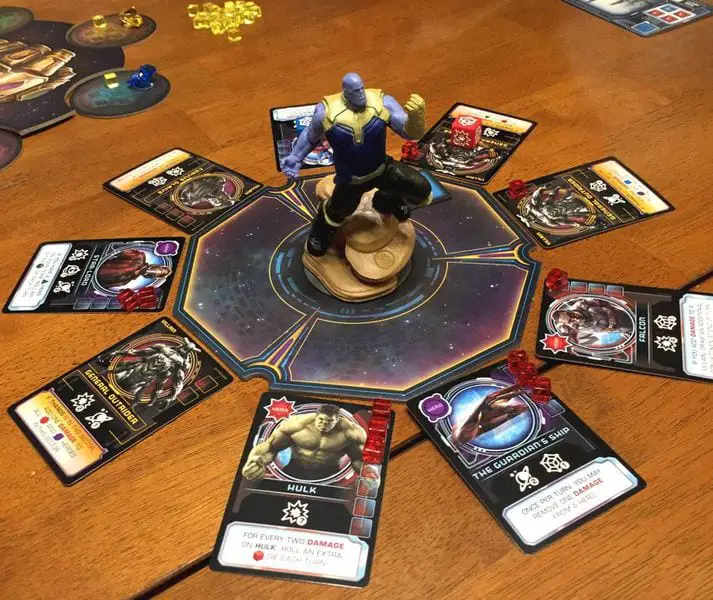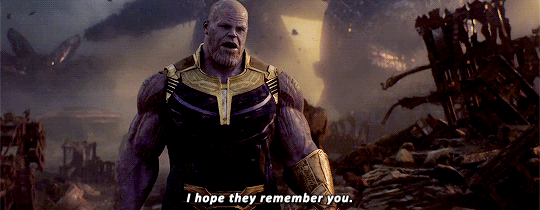*contains spoilers for Avengers: Infinity War*
I first ran into Thanos Rising: Avengers Infinity War at Gencon, where I was impressed with the presentation of the game as well as its interesting game design. I’m also a massive Marvel Zombie and a fan of the MCU, so when USAopoly gave me the chance to check the game out up close and review it, I was solidly hype. What I found was a challenging and fun addition to USAopoly’s library, one that doesn’t get too lost under its (extremely well handled) license.

What’s In The Box?
The difference between a villain and a supervillain is presentation. And USAopoly did not disappoint in its presentation of Marvel’s ultimate baddie. This is hands down one of the prettiest and well-made games I’ve ever played. It has all of the polish and care you expect from USAopoly, but with that little extra oomph of quality that comes with a Disney license. As I noted in my GenCon article, the big feature is Thanos himself, a statue so well done that I don’t even keep it in the box. I actually have it on my shelf next to my other statues and figures (It’s an integral part of the game, however, so if you choose to display it don’t let it wander), The other big standout pieces are the infinity gems themselves. Somehow, USAopoly was able to make better infinity stones than those weird eggs Capcom sent out last year. They each have a distinctive shape, chunky, and well made enough to very nearly feel like real stones. Best of all, all five stones slot onto the Infinity Gauntlet board beautifully (as they should). The rest of the game is well colored and highly detailed, using glossy images from across the Marvel Universe in tandem with a gorgeous palette of colors that really make the game pop. Even the dice, both the one for Thanos and the ones for each player, are chunky and embossed rather than printed, meaning they feel great to handle and won’t ever have their graphics rub off.
How’s It Play?

It’s kind of hard to describe the gameplay of Thanos Rising. It has elements of a deck builder, resource management game, dice allocation, and strategy game all rolled up with some extra bits thrown in. The basic premise is that each player represents as “team” of Avengers participating in Infinity War and representing a different part of the Marvel Universe. You can be Dr. Strange (mystic heroes), Thor (the cosmic science/mystic heroes), Black Panther (the tech heroes), Gamora (the tech/brawling cosmic heroes) and finally Captain America (the brawling heroes). Each has a team leader who benefits from building a hero team around them that plays to their strengths. While oftentimes the heroes your leader teamed up within Infinity War also work with them here, there’s always overlap and some heroes that fit who never even MET in the film. In my playthrough as Dr. Strange, I had Wong, Heimdall, Loki, and a Quinjet (there’s also weapons) on my side, while the player acting as Gamora had the Hulk and Spider-Man (together at last!) These heroes help you earn battle points, gain bonuses, and work with your fellow Avengers to defeat the Mad Titan. But how does one gain these heroes?
The centerpiece of the game is, of course, Thanos, and the “Deployment Zone” in which he sits. Each turn consists of a hero turn and a Thanos turn, and the game is set up as essentially a big boss battle. In a Thanos turn, the special Thanos die is rolled to determine what his action will be. Most of the time he’ll move either clockwise or counterclockwise to a new sector, but he doesn’t always. The sector he’s in affects the game by hurting any freelance heroes in that sector (if they die, they cannot be recruited), and any villains like General Outrider get to use their abilities. If Thanos doesn’t move, he either makes ALL of the villains in the other sectors activate, or he gets a step closer to the Infinity Stones. Oh, yeah, those. Thanos obtains THOSE by rolling the Infinity Stone die with his own, and adding a counter to the color on which it lands. Once there’s five or more on a stone, Thanos acquires it and gains its powers. YOU DO NOT WANT THIS. All of the powers the stones grant are extremely powerful and having just one activated can make the game ten times harder. If Thanos gets all six stones then you get the super fun canon ending: the heroes lose, Thor forgets the difference between a chest and a head, and half the universe turns to dust. Also, the game ends.

So, with all that, how can a hero fight back? Well, the heroes win condition is simple: beat ten villains. They have to do this without either their own team being wiped out or without losing 10 heroes between the players. Each player has a pool of dice particular to them that they use to essentially buy heroes or damage villains. Each hero/villain has a combination of symbols (tech, mystic, or strength) one must have to either acquire them, for the former or damage them, for the latter. Some are very cheap and require only a few dice, others are very expensive and need a complex array of dice for the player to affect them. The game then continues with each player doing this, then Thanos taking a turn, then the heroes again. It goes until any of the end conditions are met, with the Gauntlet acting as a sort of timer for the game as a whole.
This is a hard, HARD game. And that isn’t necessarily a knock on it. It’s just the game is kind of designed for you to lose, and it only takes a good deal of practice and luck to beat Thanos. My group did the easy mode of only beating seven villains and we STILL lost. Thanos can and will snowball hard in the mid to late game thanks to the Infinity Stone abilities, and there is less mitigation of the stones than for other things. So if you’re interested in this game, just keep in mind that you will probably lose your first few times. Or more. But that’s sort of a motif of the film, isn’t it? It’s an interesting risk that USAopoly has taken in making this game so hard, as it adds to the flavor of the game in a way that actually affects the gameplay. It is not, however, impossible, and it is a blast learning what combos of heroes work, which ones don’t, and which patterns help you defeat Thanos and avert destiny.
The Verdict

I think this is really a game more for big MCU fans than general board game audiences. Oh, that’s still basically everyone? Alright, well then. I do think that despite the family-friendly nature of the MCU films, Thanos Rising is definitely for gamers who are fairly seasoned, as it is pretty complex and experience with strategy games will smooth the learning curve a little. On the flip, this is also not a bad entry point for teenage or adult players who want to try a game that’s considerably deeper than the board games they’re used to but are a little intimidated by the old standby strategy games. The unique playstyle, polish, and popular license all mean that it has enough to keep everyone interested. Plus, the mish-mash style of the gameplay means it can serve as an introduction to other types of board games in the hobbyist sphere, ones that throw around terms like “dice allocation” with reckless abandon. For the Marvel Zombies, though, this is a massive treat to play through even if you end up losing. Any Marvel fan should look out for this game to add to their collection, even if they’re not a big collector. And while some hardcore board gamers balk at licenses, they should definitely give this well-made and unique game a spin if they get the chance.
![]()
![]()
![]()
![]()
![]()
Avengers Infinity War: Thanos Rising is available, in the US and Canada only, from USAopoly, Amazon and at your local game shop, where it retails for $49.95. Thanks to USAopoly for the materials and images used for this review! And stay tuned to the Fandomentals for more board game reviews and news, as well as all the latest from the Marvel Cinematic Universe!

